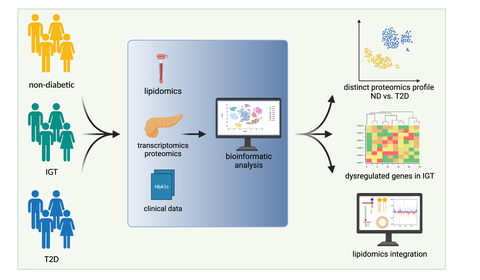Jun 28, 2021
New study reveals heterogeneous beta cell trajectories toward type-2 diabetes

Created with BioRender.com
Type-2 diabetes (T2D) defines a cluster of complex pathological states characterized by persistent hyperglycemia, often leading to cardiovascular complications, kidney failure, retinopathy and neuropathies. Affecting more than 450 million people, with rising incidence rates over the past decades, this syndrome is a major threat for public health and society globally. However, existing studies do not sufficiently describe the molecular changes of pancreatic islet beta cells leading to their deficient insulin secretion. Now, an international research team led by investigators at the Paul Langerhans Institute of the Helmholtz Zentrum München at the University Hospital and Faculty of Medicine Carl Gustav Carus of TU Dresden, the SIB Swiss Institute of Bioinformatics, and the Max-Planck-Institute of Biochemistry addressed this deficiency with a comprehensive multi-omics analysis of metabolically profiled pancreatectomized living human donors stratified along the glycemic continuum from normoglycemia to T2D. The outcome of this highly collaborative project has now been published in the renowned journal “Nature Metabolism (Nat Metab)”.
Common determinant and ultimate cause of T2D is the inability of pancreatic islet beta cells to secrete insulin in adequate amounts relative to insulin sensitivity. Beta cell failure typically results from a lengthy process spanning many years. Remarkably, it can be rapidly reverted upon bariatric surgery or severe caloric restriction. Hence, a prevailing opinion is that persistent metabolic stress drives mature beta cells to phenotypically de-differentiate into progenitor cells or trans-differentiate into other islet endocrine cell types over time.
“Previously, insight into molecular alterations associated with impaired insulin secretion in T2D has been largely obtained from pancreatic islets isolated enzymatically from brain-dead or cadaveric subjects classified according to a categorical division into non-diabetic and diabetic, rather than on a continuum from euglycemia to steady hyperglycemia”, explains Marko Barovic, PhD student in the Solimena lab of the Paul-Langerhans-Institute Dresden and one of first authors of the study. “We have attempted to overcome these shortcomings, at least in part,with the establishment of a complementary platform for the procurement of islets which relies on the collection and analysis of pancreatic specimens from metabolically profiled living donors undergoing pancreatectomy for a variety of disorders”.
“This study provides an extensive analysis on islets in situ and plasma samples from the largest cohort of in-depth metabolically profiled living donors”, says Leonore Wigger, who works with Dr. Mark Ibberson at the SIB. “Multi-omics data were generated using state-of-the-art approaches and integrated in a fashion not previously used in studies on islet dysregulation in relation to hyperglycemia in humans. The integrative analysis of lipidomics and transcriptomics data enabled us to identify gene co-expression modules and lipid species predictive of HbA1c levels. Additionally, data from islets in situ of non-diabetic subjects represent a valuable reference for future investigations. Furthermore, we could identify for the first time a set of islet genes altered in their expression already in subjects with impaired glucose tolerance. This, in turn, enabled us to acquire an unprecedented cross-sectional overview of the progression of islet gene dysregulation in parallel with the continuous elevation of HbA1c values, beyond conventional thresholds for clinical classification of patients.”
Among those genes, ALDOB (Aldolase B) stands out as being the one with the strongest correlation with elevated HbA1c. Since ALDOB is a marker of beta cell precursors, its overexpression could be interpreted as a sign that in T2D, mature beta cells revert back to an immature stage of differentiation, or that a compartment equivalent to the lifelong niche of virgin beta cells identified in adult mice expands as a potential compensatory source of new beta cells. “The global unbiased proteomic analysis used in this study corroborated the upregulation of ALDOB and further showed that the expression profile of islet cells in individuals with T2D is very divergent, opposite to its remarkable homogeneity in islet cells of non-diabetic subjects. Hence, the regression of beta cells toward a de-differentiated state following a linear trajectory recapitulating their developmental path to maturation or their transdifferentiation into other islet cell types seems less likely than a disharmonic relaxation of constraints on gene expression”, explains Andreas Brunner, PhD student in the lab of Prof. Matthias Mann at the Max-Planck-Institute for Biochemistry. Proteomics studies confirmed the changes in mitochondrial and transcription/translation machinery found in the transcriptomic analyses. An avenue for further research is suggested by findings that in beta cells of T2D subjects the acetylation of histone proteins, which control the packaging of the DNA and gene expression, is enhanced.
This project has received funding from the Innovative Medicines Initiative 2 Joint Undertaking RHAPSODY and the German Center for Diabetes Research (DZD e.V.) amongst others.
Original Publication:
Wigger L, Barovic M, Brunner AD, Marzetta F, Schöniger E, Mehl F, Kipke N, Friedland D, Burdet F, Kessler C, Lesche M, Thorens B, Bonifacio E, Legido Quigley C, Barbier Saint Hilaire P, Delerive P, Dahl A, Klose C, Gerl MJ, Simons K, Aust D, Weitz J, Distler M, Schulte AM, Mann M, Ibberson M, Solimena M. Multi-omics profiling of living human pancreatic islet donors reveals heterogeneous beta cell trajectories toward type 2 diabetes
doi:10.1038/s42255-021-00420-9
